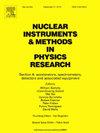CLLBC闪烁探测器对γ射线和中子响应的表征
IF 1.5
3区 物理与天体物理
Q3 INSTRUMENTS & INSTRUMENTATION
Nuclear Instruments & Methods in Physics Research Section A-accelerators Spectrometers Detectors and Associated Equipment
Pub Date : 2025-04-18
DOI:10.1016/j.nima.2025.170470
引用次数: 0
摘要
双模闪石材料CLLBC (c2lilabr 4.8 Cl 1.2:Ce)能够同时测量γ射线和中子。中子探测能力范围从热能到约10兆电子伏,使这些探测器成为研究快速裂变中子能谱(PFNS)的有吸引力的选择。在这项工作中,对CLLBC探测器进行了全面的表征。对三种CLLBC探测器进行了表征,并对三种labr3:Ce和两种labr3:Ce,Sr进行了比较。对于性能最好的CLLBC探测器,结果表明,在γ=662 keV时,能量分辨率为3.7%,在γ=1MeV以上,使用60Co的固有时序分辨率为1.2 ns (FWHM)。通过脉冲形状判别,获得了2.7的γ-中子分离优值。利用241Am9Be中子源,通过对4.44 MeV γ射线和中子的同步探测,进行了标记中子飞行时间的测量,确定了2-6 MeV之间的固有中子探测效率。6Li(n,t)4He反应的中子探测效率约为0.2%,三种(n,n’)反应的中子探测效率约为1%。所研究的三个CLLBC探测器中有两个表现出能量峰不对称,导致性能较差,表明闪烁体质量问题,并激励进一步研究。预计未来的研究将使用252Cf(sf)提示裂变中子谱来确定更大范围内中子能量的中子效率。虽然在之前的研究中观察到,通过35Cl(n,p)35S进行的中子探测在这项工作中没有被确定,但计划使用JRC MONNET设施产生的准单能中子来确定。本文章由计算机程序翻译,如有差异,请以英文原文为准。
Characterization of CLLBC scintillation detector response to γ-rays and neutrons
The dual-mode elpasolite scintillation material CLLBC ( 2 4.8 1.2:Ce) is capable of measuring both -rays and neutrons. The neutron detection capability spans from thermal energies up to about 10 MeV, making these detectors attractive options for studying prompt fission neutron spectra (PFNS). In this work, a comprehensive characterization of CLLBC detectors is performed. Three CLLBC detectors were characterized, in addition to three 3:Ce and two 3:Ce,Sr for comparison. For the best-performing CLLBC detector, the results indicate an energy resolution of 3.7% at keV and an intrinsic timing resolution of 1.2 ns (FWHM) above using 60Co. A -neutron separation figure-of-merit of 2.7 is obtained by means of pulse-shape discrimination. Tagged neutron time-of-flight measurements were conducted using a 241Am9Be neutron source, by coincident detection of the 4.44 MeV -ray and the neutron, to determine the intrinsic neutron detection efficiency between 2–6 MeV. Neutron detection efficiencies of about 0.2% for the 6Li(n,t)4He reaction and 1% for three types of (n,n′) reactions were obtained. Two of three investigated CLLBC detectors exhibit an energy peak asymmetry, resulting in worse performance, indicating scintillator quality issues and motivating further investigation. Future studies are anticipated using the 252Cf(sf) prompt fission neutron spectrum to determine neutron efficiencies for a wider range of neutron energies. Although observed in a previous study, neutron detection via 35Cl(n,p)35S was not identified in this work but is planned to be determined using quasi-monoenergetic neutrons generated at the JRC MONNET facility.
求助全文
通过发布文献求助,成功后即可免费获取论文全文。
去求助
来源期刊
CiteScore
3.20
自引率
21.40%
发文量
787
审稿时长
1 months
期刊介绍:
Section A of Nuclear Instruments and Methods in Physics Research publishes papers on design, manufacturing and performance of scientific instruments with an emphasis on large scale facilities. This includes the development of particle accelerators, ion sources, beam transport systems and target arrangements as well as the use of secondary phenomena such as synchrotron radiation and free electron lasers. It also includes all types of instrumentation for the detection and spectrometry of radiations from high energy processes and nuclear decays, as well as instrumentation for experiments at nuclear reactors. Specialized electronics for nuclear and other types of spectrometry as well as computerization of measurements and control systems in this area also find their place in the A section.
Theoretical as well as experimental papers are accepted.

 求助内容:
求助内容: 应助结果提醒方式:
应助结果提醒方式:


